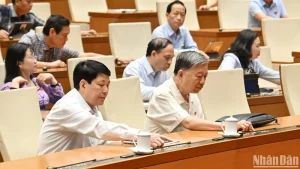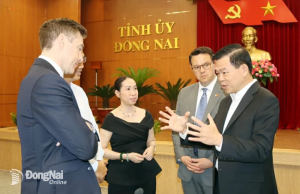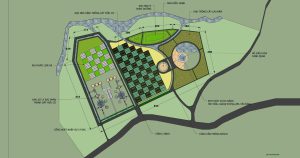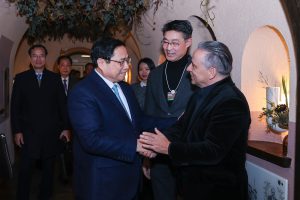Economic shift towards circular economy, green economy, low carbon economy is the inevitable trend of the times. Vietnam’s goal in transitioning from a linear economy to a circular economy focuses on three pillars: design, extending the material life cycle; reduce waste and emissions; restore the ecosystem.”

Economic shift towards circular economy, green economy, low carbon economy is the inevitable trend of the times. Vietnam’s goal in transitioning from a linear economy to a circular economy focuses on three pillars: design, extending the material life cycle; reduce waste and emissions; restore the ecosystem.”
The above information was given by Minister of Natural Resources and Environment Tran Hong Ha at the webinar “Circular economy in emerging markets: Green recovery potential in developing Asia,” held out on the afternoon of 2/6.
The workshop was organized by the Institute of Strategy for Natural Resources and Environment Policy (Ministry of Natural Resources and Environment) in collaboration with the Asian Development Bank Institute (ADBI) and the Finnish Innovation Development Fund (SITRA).
This is a regional sideline workshop of the World Circular Economy Forum to introduce policy documents, review case studies on successful implementation of the circular economy; related principles and recommendations, focusing on green recovery and economic growth after the COVID-19 pandemic.
The seminar was attended by representatives of ministries in the fields of: natural resources, development, industry and trade, economy, climate change… of countries in the Asia-Pacific region, local authorities, representatives from the private sector as well as global experts.
At the workshop, participants focused on regional and national legal, regulatory and policy frameworks, opportunities for the private sector, and innovation in cities that can help unlock the potential of cities. capabilities of the circular economy approach.
Delegates also focused on discussing the potential of a circular economy to support recovery from the COVID-19 pandemic; barriers to integrating the circular economy concept into sustainable development frameworks; building official government knowledge and capacity to formulate policies towards a circular economy; review country case studies, highlighting best practices for transitioning to a circular economy.
At the discussion session themed “From linear to circular – what will happen?,” Minister Tran Hong Ha said that the complicated development of the COVID-19 pandemic has affected all aspects of economic life. -global society, changing the perception of people all over the world, deepening the demand for changing growth models towards sustainable development.
Economic shift towards circular economy, green economy, low carbon economy is an inevitable trend of the times, globally agreed and considered by countries around the world as a green industrial revolution. of the 21st century. This is an opportunity for the global community to join hands to fulfill international commitments in the field of environmental protection and response to climate change, aiming at sustainable development for the health of people. people, the natural environment and the Earth.
Implementing the circular economy is a way for Vietnam to fulfill its international responsibility in fulfilling its commitments on environmental protection, helping businesses reduce risks of over-product crisis and resource scarcity; create motivation to invest, innovate technology, reduce production costs, expand supply chains, and at the same time create new markets, new job opportunities, improve the health of people, communities and the world nature.
Vietnam has institutionalized the circular economy in the Law on Environmental Protection. Vietnam’s goal in transitioning from a linear economy to a circular economy focuses on three pillars: design, extending the material life cycle; reduce waste and emissions; ecosystem restoration.
For the purpose of design, prolonging the material life cycle, Vietnam focuses on product design and technological processes to create products in order to minimize the exploitation of raw materials, non-metals, non-metals, and energy. volume, fossil fuels, biomass; while eliminating waste and pollutants throughout the product supply chain from design, extraction, processing, production, distribution, consumption, collection, classification, waste treatment, and extraction waste recycling.
The design is assessed by scientists around the world to decide 80% of the waste generated in the economy, therefore, Vietnam considers this to be a decisive breakthrough.
For waste and emission reduction, Vietnam aims to keep products and materials used to their maximum in the economy through the 9R strategy (reject, reduce, redistribute/reuse) use, remodeling, refurbishment, remanufacturing, repurposing, recycling, energy recovery, and waste reprocessing).
With the goal of restoring ecosystems, Vietnam aims to promote the regeneration and restoration of natural ecosystems.
When implementing the circular economy, Vietnam not only aims to reduce the exploitation of raw materials, fossil fuels, primeval forests, natural water sources, and reduce waste, greenhouse gas emissions, and reduce greenhouse gas emissions. Minimizing burying and burning waste without recovering energy… but also aiming to regenerate natural ecosystems, protect, conserve and develop natural capital land, water, forest, sea and biodiversity, protection of living things on land and in water.
This is also the goal of the United Nations and the United Nations Environment Program to implement a Decade of Ecosystem Restoration from 2021 to 2030, launched in June, on the occasion of World Environment Day June 5.
“In response to World Environment Day, during this Environmental Action Month and a decade of Ecosystem Restoration, we have been launching many programs that inform and encourage the promotion of the circular economy. for the business community and residents, with the aim of promoting eco-design, promoting circular economic processes, encouraging sustainable production and consumption, and to ensuring that waste and pollution are prevented. prevent, natural capital resources are stored and used to the maximum in the economy,” said Minister Tran Hong Ha.
According to Minister Tran Hong Ha, for a successful transition to a circular economy model, it is necessary to involve all stakeholders from government agencies, mining enterprises and raw materials. , processors, manufacturers, distributors, retailers, consumers, garbage collectors…
The report submitted to the 13th Party Congress pointed out that, in the period up to 2025, “build a roadmap, mechanism, policy and law to form and operate a circular economy model,” “encourage development.” circular economy model for the integrated and efficient use of the output of the production process”…
Minister Tran Hong Ha said that currently, according to the provisions of the Law on Environmental Protection 2020, the Ministry of Natural Resources and Environment is presiding over and coordinating with relevant agencies to develop regulations on “criteria, road map, process and mechanism to encourage the application of circular economy in Vietnam.”

The roles and responsibilities of ministries, branches and localities are now clearly defined in the Law, associated with the roadmap for the implementation and implementation of the circular economy in Vietnam. The Ministry of Finance is coordinating with the Ministry of Natural Resources and Environment in restructuring the system of economic and financial instruments in the field of natural resources and environment, ensuring synchronization, consistency, security and safety. the whole national finance; suitable to the socio-economic conditions and environmental protection requirements in each period of Vietnam. Financial instruments that play an important role in the transition to a circular economy need to be coordinated between the two ministries to complete such as taxes, environmental protection fees; preferential policies, support for environmental protection, recycling and reuse of waste in the economy; policies on green credit and green bonds; price control policy of the state… Regarding digital transformation, the Ministry of Natural Resources and Environment is coordinating with the Ministry of Information and Communications, ministries and branches to build an information system and database of the natural resources and environment sector to implement the Transformation Program. number of countries, implementing e-Government.
Hoang Nam
Reference: http://www.mpi.gov.vn/pages/tinbai.aspx?idTin=50242&idcm=49




Leave a reply